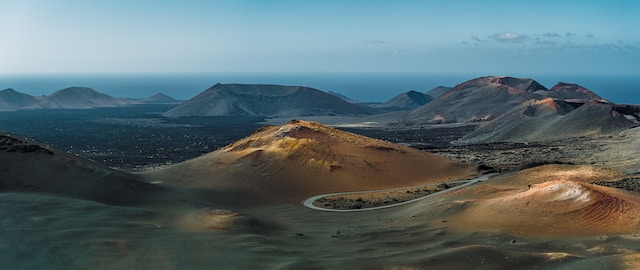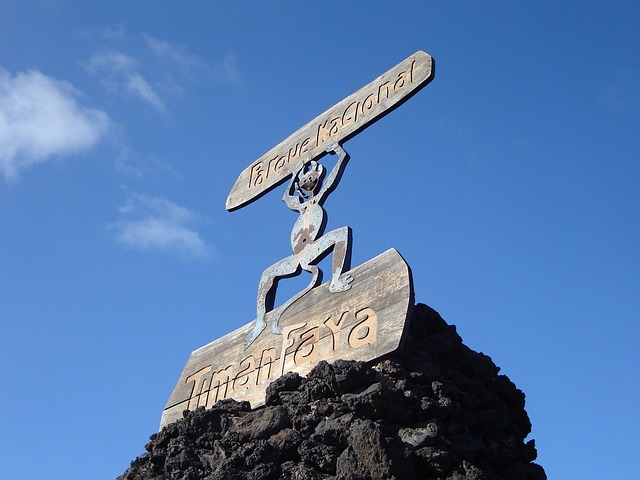The Timanfaya Devil Legend is a popular folktale from the Canary Island of Lanzarote. It tells the story of a young couple who were married on the day of a major volcanic eruption. The eruption killed the bride, and the groom was so overcome with grief that he turned into a devil.
The origin of the Timanfaya Devil Legend
The legend of the Timanfaya Devil is well known in Lanzarote. It is believed to have originated in the 18th century, during the volcanic eruptions that devastated the island.
But some people believe the legend was created years after that, as a way to explain the natural forces that caused the eruptions. Here we will tell you the story, so that you know it and can judge for yourself.
The legend tells the story of a couple who was getting married at the village of Timanfaya on 1st September 1730. While the ceremony was taking place, the volcano began to erupt.
Everyone began to seek shelter, but before the couple could escape, a rock fell on top of the bride. The groom took a five-pronged forge with which he attempted to lift the rock, but when he succeeded, he found the bride dead. Still, he picked her up and tried to find shelter, but he didn’t find a safe place.
In desperation, he lifted the five-pronged forge with both hands, and then disappeared.
Those who witnessed the scene could only say “poor devil”.
If you are planning a trip to Lanzarote, this is the story you’ll hear about the Timanfaya Devil legend. Also, you’ll see its image at the Timanfaya National Park.
Cultural significance in Lanzarote
The legend of the Timanfaya Devil is an important part of Lanzarote folklore and culture. It is often told to tourists to explain the origin of the Timanfaya National Park. It is also a popular subject of art and literature.
The landscape described in the legend is the Timanfaya National Park. This is a popular tourist destination on the island, and it offers a variety of activities to the visitors. At this 5 thousand hectares park, you can see the Mountains of Fire, take a walking tour or witness geothermal demonstrations.
This legend has helped to shape the island’s identity and to create a sense of place. Now, the figure of the devil holding the fork above his head is the symbol of the park.

Historical context of the Timanfaya Devil
The volcanic eruptions of 1730
September 1, 1730 marked the history of the island. On this date, the eruptions began that devastated the island. The volcanic eruptions 1730 lasted six years, and they changed Lanzarote as everyone knew it.
People were forced to flee their homes. The lava covered half of the island, including villages and farmland.
The eruptions had a profound impact on the island of Lanzarote. They changed the landscape of the island forever, and they left a legacy of fear and destruction.
Consequences for the Population and Natural Environment
The eruptions that occurred in Lanzarote between 1730 and 1736 had a profound impact on the local population. Extensive areas of arable land were covered by lava and ash, and crops were destroyed. At that time, agriculture was the backbone of Lanzarote’s economy.
Many of the inhabitants of the affected communities had to abandon their homes due to the destruction. This migration, along with the loss of agricultural land, led to changes in Lanzarote’s social and economic structure.
The island’s inhabitants had to adapt to the new reality. This led to a new method of farming, which can still be observed in La Geria. Over the years, the tourism industry also developed, which is now a vital part of the island’s economy.
The natural environment was also impacted by the eruptions: they created new volcanic landscapes, such as craters, lava fields, and volcanic cones.
With the changing environment, new species adapted to the altered conditions emerged.
Folklore and its evolution over time
At first, the myth of Timanfaya Devil just told the story about the tragedy that came to the life of the young couple. But over time, it evolved, and later versions became more elaborate.
Sometimes the devil is described as a fearsome creature. Other versions represent it as a more sympathetic figure, who is simply grieving the loss of his beloved.
This tale not only reflects the rich cultural heritage of Lanzarote, but is also a reminder of the power of nature, and the resilience of the human spirit.
Exploring the myth of the Timanfaya Devil
¿Is this story real? Certainly, the legend is rooted in local beliefs and stories. And you will hear about the devil during your trip to Lanzarote. But it is also said the tale was born years after the eruptions ended, and there was not such a tragedy during a wedding when they started.
There are some interpretations and key elements to the story. First, we have the devil with the five-pronged fork. This image, which you can see at Timanfaya National Park, was created by the artist César Manrique in 1968.
Also, some variations have become popular. It is said the Aloe Vera plant began to sprout in the place where the bride’s blood was shed. The plant was given this name to remember the young couple: his name was Aloe and hers was Vera.
Cultural and Symbolic Significance of the Timanfaya Devil
The image of the Timanfaya Devil is associated with the idea that the fire and magma of volcanic eruptions are elements to be respected and feared.
Local Interpretations of the Symbol
For Lanzarote’s people, the legend represents the natural force and destructive power of volcanoes. The Timanfaya eruptions were devastating, and the Devil became a figure embodying fear and respect for these natural phenomena.
Some also view the figure of the Timanfaya Devil as a guardian of the landscape. It is an image that protects the land and natural resources.
The Timanfaya Devil has a strong presence in Lanzarote’s cultural identity. In addition to oral stories, it frequently appears in festivals and cultural events.
Comparison with Similar Legends in the Canary Islands
Each of the Canary Islands has its own legends that have been passed down from generation to generation. In La Palma, for example, there is the story of El Salto del Enamorado (The Leap of the Lover), which tells of a shepherd in love with a wealthy young woman. To win her love, he accepted the challenge of leaping over a cliff three times, falling to his death on the last attempt.
In Tenerife, there is the legend of Amarca. This is the story of a shepherd who fell in love with young Amarca and took his own life after being rejected. Other women, jealous of Amarca’s beauty, blamed her for the shepherd’s fate. As a result, she had to leave the village and later also took her own life, overcome by guilt.
Artistic Representations
This legend has a deep cultural significance in Lanzarote. Even today, it continues to capture the imagination of people of all ages. The figure has been depicted in various artistic expressions, including paintings, sculptures, and music.
César Manrique was in charge of shaping the sculpture of the demon that is exhibited in the park today. Manrique’s sculpture is located in the Timanfaya Visitor Center, and it is a popular tourist attraction.
Impact on tourism and local beliefs
There are people in Lanzarote who think the devil is real and that this is a ferocious creature. and they avoid going to the lava fields at night. The legend has helped to create a unique identity for the island, and it is a source of pride for many of the island’s residents.
Everyone in Lanzarote knows the legend, and locals make sure the tourists get to know it too. Visitors to the island are often drawn to the legend, and they may seek out opportunities to learn more about it.
During the visit to the Timanfaya Nartional Park, the tourists have the opportunity to know more about the story, and experience the unique volcanic landscapes that inspired it.

The devil as a symbol of natural power
The Timanfaya Devil represents the power and mystery of the volcanic landscapes. The legend reminds us of the need to respect the power of nature and to be cautious when dealing with volcanic environments.
But the legend is not just about the destruction that eruptions can provoke, but also about creation. It tells us the story about how the volcanoes gave shape to the landscape in Lanzarote as we know it today.
Frequently Asked Questions About the Legend of the Timanfaya Devil
Is the Story of the Timanfaya Devil Real?
The story of the Timanfaya Devil is a legend that popular tradition has preserved to this day. The image known as the Timanfaya Devil is a creation by Lanzarotean artist César Manrique.
Where Can You See the Devil Symbol in Lanzarote?
The image of the Timanfaya Devil can be found in the Timanfaya National Park, located between the municipalities of Yaiza and Tinajo. This image, depicting the devil holding a five-pronged fork above its head, welcomes visitors to the park.
What Activities Related to the Legend Can Be Enjoyed on the Island?
Visit the Montañas de Fuego (Mountains of Fire), formed during the eruptions described in the legend. Within Timanfaya National Park, you can dine at El Diablo restaurant, known for cooking food using the heat emanating from the earth. Additionally, keep an eye out for cultural activities held on the island throughout the year.
In Lanzarote Transfer, we encourage you to learn more about the Timanfaya Devil legend. Have you heard about this story before?
Our company seeks to deliver the best service you can find on the island today. We seek to optimise our clients’ time and resources, which is why we respect the schedules and offer the best prices for different transfers.








